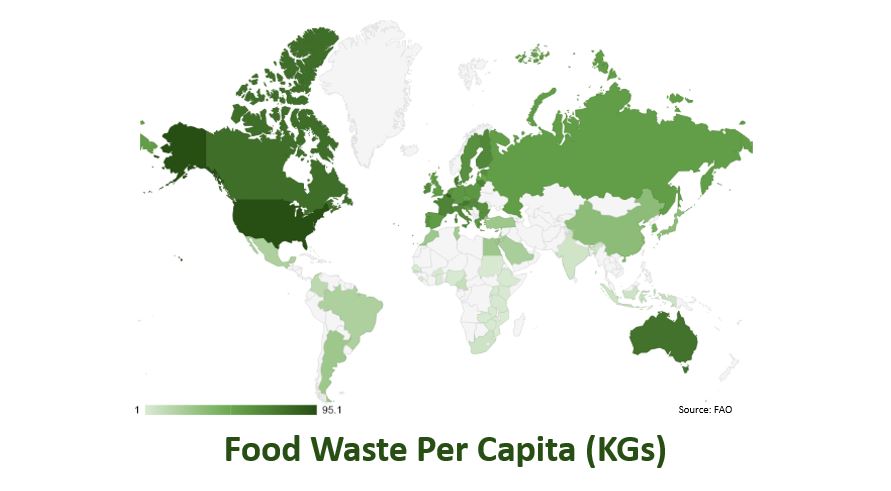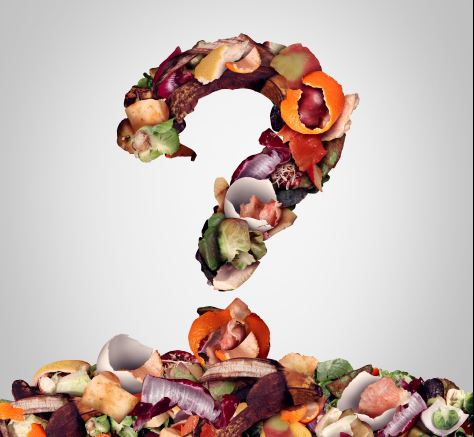Supply chain waste is a major contributor to the global food waste problem. According to the United Nations Food and Agriculture Organization (FAO), supply chains cause 40% of food waste in North America. Yet, unfortunately, too few people realize that problems in the fresh food supply chain contribute to the waste experienced by retailers and consumers. All too often, the blame for the waste is placed on people that really can’t do much to prevent it.
The USA is the Leader in Waste
According to a recent article in Supply Chain Dive, the United States had the largest amount of food waste per person with estimated 210 pounds (95.1 kilograms) per person per year. In developed countries, the largest source of food waste is typically the consumer. But the article points out that there are massive issues with the supply chain that contribute to food waste.

The USA leads the world in food waste per person. (Credit: Matt Leonard / Supply Chain Dive, data from BCFN)
The Causes of Supply Chain Waste
The article cites a number of contributors to the supply chain waste problem including:
- Not having enough labor to harvest the entire crop production so growers will leave some in the field to rot.
- Retailers are too focused on the look of an item of produce which may be too large or small or misshaped. If they don’t think it will sell, they leave it behind and it becomes waste.
- Lack of proper refrigeration and packaging during shipments from producers to retailers. This is often referred to as “cold chain integrity” or “cold chain compliance” but, in reality, it entails more than what most people think. Simply knowing that a trailer’s cooler is on doesn’t prevent food waste.
- Delays in shipments due to onsite bottlenecks, traffic, weather and other factors.
- Retailers over-ordering to keep shelves “overstocked” with the perception that customers prefer the abundance of product on the store shelves. Interestingly, an article in Grocery Business cites a study by Stop & Shop who analyzed its overstocking practices. The article says “the company found overfilled displays not only led to spoilage on the shelf but also could displease customers due to spoiled product and require more staff handling to sort out the damaged items. In its study, customer satisfaction actually increased when shelves were not overstocked.”
Certainly, the factors above are contributors to the supply chain waste problem. But let’s start at the beginning of the supply chain where the cause of food waste often begins.
But Where Does the Cause of Supply Chain Waste Really Start?
Consumers often buy more food than we need leading to food waste. Sometimes we buy food for dinner at home but then decide to go out to eat. Or something’s on sale so we buy more of it than we actually need. But, in truth, a good portion of the food consumers waste may not truly be the fault of the consumer at all. That is, we can do everything right in terms of planning our purchases and yet create food waste.
Too often we buy food and expect it to last for four or five days only to have it spoil the day after we buy it and into the trash it goes. We may get frustrated with the store and blame this premature spoilage on them but where does the problem actually start? Who’s at fault? What’s causing that premature spoilage?
Zest Labs’ research has shown that the primary causes of food waste occur in the first 24-48 hours after the food is picked or cut due to harvest conditions and post-harvest processing. Produce may sit in the (hot) field for one to five hours (or more). There may be delays getting the trucks into the receiving yard and into precooling, creating long cut-to-cool times. (We’ve seen as much as nearly nine hours!) There may be insufficient or uneven precooling.
All of these situations mean that the produce is spending time at “field heat” temperatures where each hour can mean a loss of a full day of shelf-life. A pallet with a cut-to-cool time of five hours would have four days fewer shelf-life than a pallet with a cut-to-cool time of one hour. That four day variation, which can’t be seen visually, can lead to premature spoilage along the fresh food supply chain that turns into food waste – either at the grocery store or with the consumer.
The Key to Preventing Food Waste
The Supply Chain Dive article quotes Brian Lipinski, an associate at the World Resources Institute, who says “Data is another big problem in food waste. The numbers considered to be the gold standard for worldwide food waste come from the FAO, but the organization has not released new data since 2011. Metrics need to be standardized and tracked on a regular basis to know if improvements are being made.”
Having data is key – and it’s also been problematic in agriculture which is often still a paper-based industry. Automating data collection improves the reliability and accuracy of the data.
Accurate data and the ability to gain insights about the condition of produce in real-time is essential to preventing food supply chain waste. Further, the ability to act on data in real-time can enable workers to initiate actions that can directly prevent the premature spoilage that leads to waste.
For example, we use pallet-level IoT condition sensors to autonomously collect data about the impacts of time and temperature for each pallet beginning at harvest. Using our Zest Fresh | Metrics solution, we can then identify pallets that have been waiting in the field for longer amounts of time and alert workers to prioritize those pallets for precooling, reducing the impact on freshness and helping to prevent that pallet from going to waste. With Zest Fresh | Optima, we can also accurately determine the dynamic remaining shelf-life and implement prioritized, intelligent pallet routing so that every pallet is delivered to the grocer with sufficient freshness for sale and customer enjoyment at home.
Getting Retailers on Board
The article cites a ReFed report that interviewed 15 retailers, all of whom “have begun some kind of food recovery program, but only about half were ‘aggressively pursuing prevention.’” Lipinski suggests that perhaps we should shift the focus to the financial benefits of lowering food waste numbers. There is an economic benefit to reducing waste as, according to the NRDC’s “Wasted” report, grocers throw out 10-12 percent of produce. That goes right against their profit margins.
But, more than just margins, grocers should think about their customers’ experience of seeing spoiled produce on the grocery shelves or purchasing fresh produce only to have it quickly spoil at home. We recently completed a grocery store research study that showed roughly half of produce spoils before the consumer would expect to enjoy it. In fact, 16 percent of the produce we randomly sampled had already spoiled on the stores’ shelves!
I recently experienced this personally. I was at my favorite store and was going to buy fresh green beans for dinner. I looked in the bin and saw that many were brown, and many had shriveled. No green beans this weekend. Just then another shopper came beside me and, looking at the beans, she remarked how the store should be embarrassed to display them. I agreed. She then went to the produce clerk and, well, demanded an explanation. “These shouldn’t be out on display. You should be embarrassed. Do you have better ones in back?” The flummoxed clerk went in back and brought out a fresh box of beans. They were better. The clerk then removed the displayed beans and took them in back, presumably to the dumpster. There goes five to ten pounds of beans.
Fixing the Supply Chain Waste Problem
To fix the supply chain waste problem, we need to start at the beginning of the supply chain because that’s where the problems start. By collecting data about the condition of each pallet of produce from the time of harvest and applying predictive analytics, we can identify issues and suggest corrective actions that can directly prevent food waste further down the supply chain. That way, consumers don’t have to throw out food that spoils prematurely. (And we don’t find marginal quality produce on our grocer’s shelves either.)



